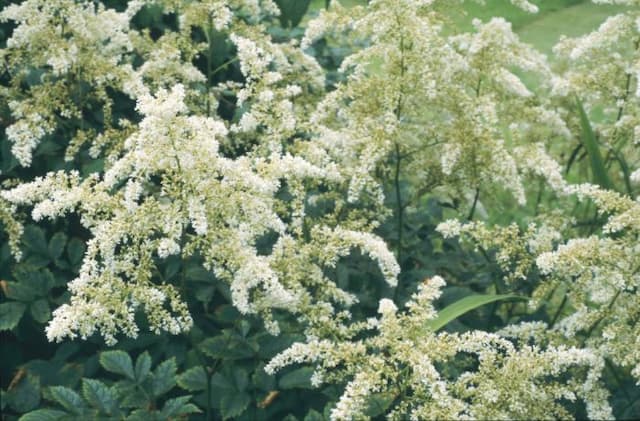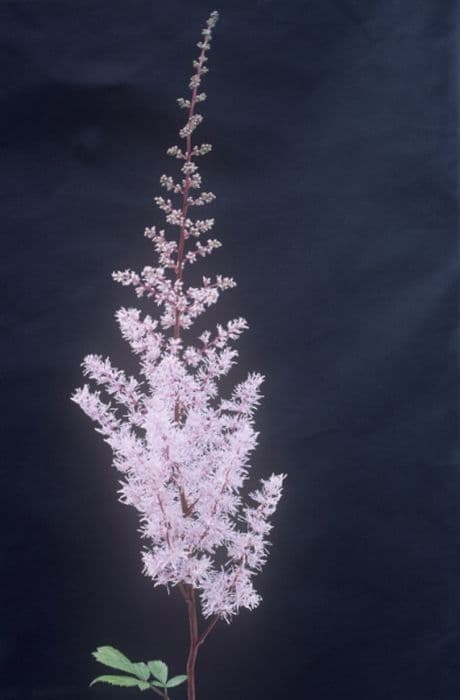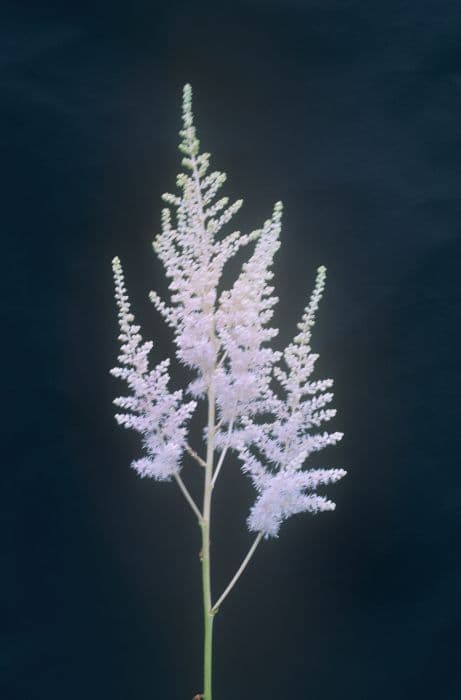Bergenia Bergenia 'Admiral'

ABOUT
Bergenia 'Admiral' is a visually striking perennial that adds interest to shaded garden areas. The plant is characterized by its large, glossy, and leathery leaves that are often rounded or heart-shaped and can change color with the seasons, often transitioning to hues of reddish-bronze as the weather cools. These leaves display a bold texture and form a dense clump or ground cover. From the rosettes of foliage emerge thick flower stalks that bear clusters of showy pink flowers. The blooms, which resemble small bells or cups held in tight bunches, typically appear in the early spring, adding a splash of vibrant color to the garden when many other plants are just waking up from their winter dormancy. The flower stalks and blooms rise above the foliage, creating a layered effect that adds depth and interest to plantings. The floral display contrasts nicely against the sturdy leaves, making Bergenia 'Admiral' a favorite among gardeners looking for a showy yet low-maintenance specimen. Beyond the flowering season, the robust foliage of Bergenia 'Admiral' continues to offer ornamental value throughout the year, making it a valuable addition to mixed borders, rock gardens, or as an underplanting for taller shrubs or trees.
About this plant
 Names
NamesFamily
Saxifragaceae
Synonyms
Elephant's Ears, Pigsqueak, Leather Bergenia
Common names
Bergenia 'Admiral'
 Toxicity
ToxicityTo humans
Bergenia 'Admiral', commonly known as Bergenia, is not widely recognized as a poisonous plant to humans. However, like many garden plants, eating significant amounts of it could potentially cause mild stomach upset. There is limited specific information regarding the toxicity and symptoms for humans ingesting Bergenia 'Adiral'. As a general precaution, it's advisable to avoid ingesting parts of ornamental plants due to potential unknown toxicities. If someone consumes Bergenia and experiences symptoms, they should seek medical advice.
To pets
Bergenia 'Admiral', commonly known as Bergenia, is not generally known to be toxic to pets. However, ingestion of any non-food plant by pets can potentially cause gastrointestinal upset, such as vomiting or diarrhea. While Bergenia is not listed on common toxic plant databases, individual animals can have unique sensitivities, and eating non-food plants can still result in discomfort. If a pet exhibits symptoms after consuming Bergenia, it is recommended to consult a veterinarian.
 Characteristics
CharacteristicsLife cycle
Perennials
Foliage type
Evergreen
Color of leaves
Green
Flower color
Pink
Height
1-2 feet (30-60 cm)
Spread
1-2 feet (30-60 cm)
Plant type
Herb
Hardiness zones
3
Native area
Asia
Benefits
 General Benefits
General Benefits- Easy to Grow: Bergenia 'Admiral' is a hardy plant that can thrive in a variety of conditions, making it an excellent choice for gardeners of all skill levels.
- Attractive Foliage: This plant offers year-round visual interest with its glossy green leaves that can turn reddish-bronze in the fall and winter.
- Drought Tolerant: Once established, Bergenia 'Adiral' can tolerate periods of drought, reducing the need for frequent watering.
- Shade Tolerant: It can grow in partially shaded areas where other plants might struggle, making it useful for filling in under trees or other shaded spots in the garden.
- Low Maintenance: Bergenia 'Admiral' requires minimal upkeep, with no need for complicated pruning or feeding schedules.
- Ground Cover: Its spreading habit makes it an excellent ground cover, helping to suppress weeds and stabilize soil.
- Seasonal Blooms: Bergenia 'Admiral' produces striking flowers in the spring, adding a splash of color to the garden after the winter months.
- Pest Resistant: It is largely resistant to pests and diseases, eliminating the need for chemical treatments.
- Attracts Pollinators: The flowers of Bergenia 'Admiral' attract bees and other pollinating insects, supporting local ecosystems.
- Edging Plant: With its compact growth habit, it can be used as an edging plant along paths or garden borders, providing structure and definition to landscaping designs.
 Medical Properties
Medical PropertiesThis plant is not used for medical purposes.
 Air-purifying Qualities
Air-purifying QualitiesThis plant is not specifically known for air purifying qualities.
 Other Uses
Other Uses- Bergenia 'Admiral', commonly known as Bergenia, can be used as a dye plant for textiles, yielding shades of beige to brown depending on the mordant used.
- The large, leathery leaves of the Bergenia can serve as natural abrasives for light cleaning tasks when dried and used gently.
- With its dense foliage, Bergenia provides excellent ground cover which can help prevent soil erosion in gardens and landscaped areas.
- The plant's robust leaves have been traditionally used as impromptu bookmarks by gardeners and plant enthusiasts.
- When frosts hit, Bergenia leaves sometimes change to reddish colors, making them suitable for adding a seasonal touch to fall floral arrangements.
- The thick leaves can be used in crafting, for instance, as natural stencils or templates for painting projects.
- Bergenia can be planted on green roofs, as it is hardy and can survive with minimal soil and maintenance, offering ecological and aesthetic benefits.
- Due to their texture and size, Bergenia leaves can be used to create acoustic absorption panels in DIY soundproofing projects.
- During the winter, the evergreen leaves of Bergenia offer visual interest in otherwise dormant gardens, providing year-round appeal.
- Leaves of the Bergenia plant can be layered between delicate items of clothing or materials when packed away to offer protection and prevent creasing.
Interesting Facts
 Feng Shui
Feng ShuiThe Bergenia is not used in Feng Shui practice.
 Zodiac Sign Compitability
Zodiac Sign CompitabilityThe Bergenia is not used in astrology practice.
 Plant Symbolism
Plant Symbolism- Tenacity: The plant's ability to thrive in rocky terrains and its leathery leaves that persist through winter symbolize endurance and resilience.
- Protection: The thick foliage of the Bergenia plant can be interpreted as a symbol of shelter and protection against adversity.
- Adaptability: Given its tolerance for a range of climates and conditions, the Bergenia represents the ability to adapt to changing environments.
- Evergreen nature: As an evergreen plant, it symbolizes everlasting or eternal elements, such as constant growth or unwavering values.
 Water
WaterElephant's Ears should be watered thoroughly when the top inch of soil feels dry to the touch, which is roughly every week during the growing season. Reduce watering in the winter, aiming to keep the soil slightly moist but not soggy. Depending on the size of the plant and the pot, this might translate to about 16-32 ounces of water each time during active growth, with less water required during dormant periods. It's important not to let the plant sit in standing water, as this could lead to root rot.
 Light
LightElephant's Ears thrive best in partial shade to filtered sunlight. They should be placed in a location where they are protected from the harsh afternoon sun. A spot that receives morning sun and afternoon shade is optimal. Indoors, a north or east-facing window with bright but indirect light would be a fitting choice.
 Temperature
TemperatureElephant's Ears prefer temperatures between 60 and 75 degrees Fahrenheit, avoiding extremes to prevent stress on the plant. They can tolerate a minimum temperature of around 50 degrees Fahrenheit, but should not be exposed to frost or temperatures below this threshold. A location away from drafts and sudden temperature changes is ideal.
 Pruning
PruningPruning Elephant's Ears is necessary to remove any withered or damaged leaves and to maintain the plant's shape. This is best done in the spring, just before the growing season begins. Pruning can be performed occasionally throughout the year as needed to remove any spent leaves, helping to focus the plant's energy on new growth.
 Cleaning
CleaningAs needed
 Soil
SoilElephant's Ears prefers well-draining soil with organic matter, a pH range of 5.5 to 7.5, and it thrives in a mix of loam, peat, and sand.
 Repotting
RepottingElephant's Ears should be repotted every 2-3 years or when it outgrows its container, which is less frequent than many houseplants.
 Humidity & Misting
Humidity & MistingElephant's Ears thrive in moderate to high humidity levels but can tolerate lower humidity environments common in homes.
 Suitable locations
Suitable locationsIndoor
Place in bright, indirect light and ensure moderate humidity inside.
Outdoor
Grow in partial shade, sheltered from strong winds.
Hardiness zone
3-8 USDA
 Life cycle
Life cycleBergenia 'Admiral', commonly known as Admiral Bergenia, begins its life as a seed which germinates in the spring after a period of cold stratification. As a young plant, it sends up a rosette of glossy, rounded leaves that grow close to the ground, becoming evergreen in mild climates. The plant progresses to maturity by developing a thick, rhizomatous root system that allows it to spread and form dense clumps. In late winter to early spring, it produces tall flower stalks adorned with pink to magenta blooms that attract pollinators and are followed by seed capsule formation. After flowering, the plant continues its vegetative growth throughout the summer and fall, with its leaves sometimes turning a reddish hue in colder weather. As a perennial, the Admiral Bergenia undergoes dormancy during the winter months, with its energy conserved in the rhizomes, before resuming active growth and repeating its cycle in the following spring.
 Propogation
PropogationPropogation time
Spring-Early Summer
Propogation: The most popular method of propagating Bergenia 'Admiral', commonly known as Elephant's Ears, is via division. This is typically done in the spring or autumn. To propagate by division, carefully dig up the entire plant, ensuring that you preserve as much of the root system as possible. Using a sharp, clean knife or spade, split the clump into smaller sections, making sure that each section has at least one growth point or "eye." Replant the divisions at the same soil depth they were previously, spacing them about 12 inches (approximately 30 centimeters) apart to allow enough room for growth. Water the new plants thoroughly after planting to help establish them. This method allows gardeners to efficiently create more plants while also rejuvenating the parent plant by reducing overcrowding.









